Hall-Troubridge Teaching Guides
These guides have been developed to provide resources to instructors interested in teaching with the Hall-Troubridge Digital Collection and to offer students the opportunity to engage with archival resources to enrich their learning experience.
Defining LGBTQIA+ Identity in the Early Twentieth Century
The material history of queerness is complicated. While not necessarily the labyrinth of closets and lurking in shadows that popular heterosexual portrayals would have you believe, queer life and history is nonetheless complex, frequently difficult to categorize, and even intricate to lace together with contemporary queer historiography and a blurred line between queer identity as personal and queer identity as political.
Radclyffe Hall and Una Troubridge left behind considerable materials after their deaths. Hall, a successful and controversial author, is remembered largely for her novel The Well of Loneliness that took up queer life and politics in the period between the First and Second World Wars. Una Vincenzo, Lady Troubridge, a sculptor and translator, lived with Hall as a romantic partner, advisor, and creative collaborator for the last few decades of Hall's life. Outliving her partner, Una Troubridge became the guardian of Hall's estate and a major force in writing and publishing biographical materials about Hall. The vast records from the pair that found their way to the Harry Ransom Center offer educators and students an intimate look into the lives of two deeply consequential figures in 20th-century LGBTQIA+ history.
For Radclyffe Hall and Una Troubridge, we begin in a historically complicated web. Queer life has existed always. The challenge for contemporary archivists and historians is parsing through the written and photographed records of the lives of queer people. LGBTQIA+ materials in museums come to us as products of different times and are often defined by legal transgression, private letters and documents, and other material remains that insist on evaluating queerness through cisgender and heterosexual understandings of the world. Queer material history requires nuance and a proper historical context to understand the challenges queer people faced at any given time and to frankly assess problematic personal and political opinions they held.
For starters, the privilege of Whiteness, wealth, and social influence aided Radclyffe Hall and Una Troubridge to avoid more serious punishment for their transgressions of social customs that until quite recently prohibited same-sex relationships. These privileges were shared by many of the other lesbian, gay, bisexual, transgender, and queer historical figures whose papers were preserved due to their proximity to fame and institutional power.
For Hall and Troubridge, our analysis of their material legacy seeks to place it in familiar territory for them: the social context of the Modernist literary and LGBTQ+ movement. However, our goal is not to showcase their photographs and private letters. Indeed, educators and students are invited to think critically about Hall's and Troubridge's involvement with right wing politics (which included open endorsements of fascism) and support for eugenics, and to better contextualize the social and intellectual movements of the time period which fascinated them. We do so, however, recognizing that queer material history is a void. Millions of queer people lived during this time. Their artifacts, too, are valuable and precious. However, multiple marginalizations such as sexism, racism, ableism, and classism have scattered these rich, enlightening material extensions of queer history to the wind. For queer material history, it is a loss from which we cannot truly recover. However, we assemble this section with humility and recognition that the historical fabric from which these materials have been cut is itself only a small fragment of the experiences of queer people who lived in the same time period as those who were deemed "worthy" of remembrance.
For those teaching with these materials, this category can be viewed as an invitation to think about other challenges that emerge from reconstructing complicated and historically nuanced LGBTQIA+ lives through archival materials. It is certainly not an exhaustive set of questions. How might you use these materials? What themes emerge that might yield themselves to further examination?
Reading Rainbows: Writing Queerness in the Early 20th Century
There was nothing new about queerness by the time the First World War ended. From two-spirit people in some Indiginous cultures to hijras in South Asia, queer relationships and people have appeared throughout written history and in a range of unrelated cultures. Settler colonization and deliberate destruction and erasure of these cultures and histories leaves a considerable gap in queer history. Modernist writing in early 20th-century Europe, however, marked an explosion in queer literature being published by openly queer people. Race and privilege offered these authors some protection (they were frequently White, wealthy, and members of nonconformist, "Bohemian" circles). This movement was not restricted to Europe. Queer authors across the world experimented with unconventional styles, forms, and publishing methods. In Chile, Gabriela Mistral became a globally beloved, Nobel Prize-winning poet. In New York City, Langston Hughes fused jazz and poetry in innovative ways. In Paris, Sylvia Beach published James Joyce's Ulysses at great personal and financial risk. Joyce later sold the rights to Random House, nearly bankrupting Beach and not offering her a penny to compensate for her unrewarded early monetary investment in the book's publication.
For Radclyffe Hall and Una Troubridge, their lives as prominent figures in the queer writing community put them in proximity to other well-known LGBTQIA+ authors of the time and help contemporary readers place their work in a broader literary context. Una Troubridge, for example, gave the world its first English translation of queer author Sidonie-Gabrielle Colette's writings. During her public obscenity trial, Radclyffe Hall found support from Virginia Woolf and her husband Leonard.
Contemporary readers might find this historical contextualization of what queer writing looked like when Radclyffe Hall and Una Vincenzo, Lady Troubridge lived useful when it comes to developing a more nuanced understanding of their lives. Students can compare the way that Hall constructs and examines gender and sexuality in The Well of Loneliness with other writers of the period taking up similar topics in their work. Similarly, Una Troubridge's own contributions to this movement come to light for educators and students alike. Partly literary history and partly an introduction to queer literary theory, these texts offer educators the chance to introduce students to the complex and changing understandings of gender and sexuality in the early 20th century and its literary movements.
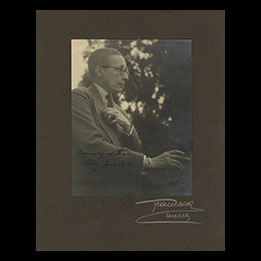
Unidentified photographer, Radclyffe Hall, 1936.
Radclyffe Hall Literary File Photography Collection P-8This picture of Radclyffe Hall shows her in her trademark tailored suit. A British writer, she published one of the most notable works of unambiguously "queer" literature in the modern age, The Well of Loneliness.
Hall enjoyed a critically and commercially successful career as a writer prior to the book's publication. She wrote other texts with implied LGBTQIA+ themes, and won awards and notoriety for her 1926 novel, Adam's Breed.
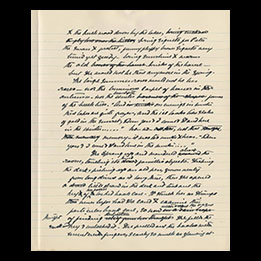
Radclyffe Hall, The Well of Loneliness, manuscript, undated.
Radclyffe Hall and Una Vincenzo, Lady Troubridge Papers 13.4Controversial upon its release, The Well of Loneliness, depicted here through a manuscript excerpt, created considerable controversy and sparked censorship and legal challenges in both the United Kingdom and the United States.
While critical response to the writing itself was mixed, the text had an enduring legacy as a watershed piece of literature for the lesbian community.
With allusions to other queer women influencing English and French literature during the 1920s and 1930s (such as the lesbian American salon host Natalie Barney), the text provides a guide to queer identity at the time, while also revealing a range of complicated and problematic scientific and political opinions that influenced Hall as an author.
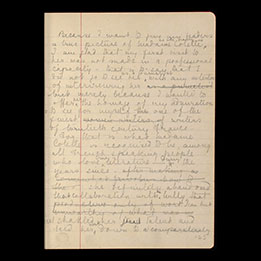
Una Troubridge, Notes on Colette, undated.
Radclyffe Hall and Una Vincenzo, Lady Troubridge Papers 34.5A gifted sculptor and translator, Una Vincenzo, Lady Troubridge was Hall's romantic partner. She is widely credited for translating the writings of Sidonie-Gabrielle Colette, better known as Colette, into English. By doing so, Troubridge introduced her pioneering work to a broader audience of English-speakers. Known for her prodigious skills as a writer and her relationships with other women, Colette was critically acclaimed. She cut her teeth as a modernist author writing books that her first husband published under his name and then crafting stories and novels under her own name in the 1920s and 1930s.
Taking advantage of her fame and the more lax urban attitudes towards lesbian relationships in Paris, Colette was part of a circle of lesbian authors and intellectuals in Paris, including Janet Flanner, Gertrude Stein, and Djuna Barnes.
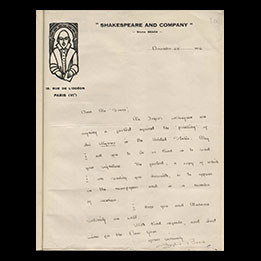
Sylvia Beach, Letter to Italo Svevo regarding Ulysses petition, December 28, 1926.
James Joyce Collection 2.17A hugely influential figure in the rise of the modernist literary movement, bookseller and publisher Sylvia Beach undertook considerable personal and financial risk when she chose to publish James Joyce's controversial magnum opus, Ulysses, in 1922. She undertook this daunting task from her Shakespeare and Co. bookstore in Paris after publishers in England and the United States refused. Beach was motivated by her deep, personal affection for Joyce and her commitment to what she perceived as the genius of the experimental book. After Ulysses proved successful with English-speaking audiences and following a decade of legal battles over censorship, Joyce took the book to a different publisher. This choice saddled Beach with tremendous debt and almost wiped out her business. The Nazi occupation of Paris in the Second World War shuttered Shakespeare and Co. permanently. However, from 1919 to 1941, Shakespeare and Co. was an icon for modernist writers living in Paris's Left Bank. During this time in France, she lived with her partner, Adrienne Monnier, until the latter's death by suicide in 1955.
In this letter, Beach is attempting to shore up support for Joyce's text by soliciting signatures for a petition against the text's censorship in the US, which would later be the subject of a 1933 court case in which American courts determined the book was not obscene, opening up American audiences to modernist texts from Europe that had previously been banned due to "explicit sexual content."
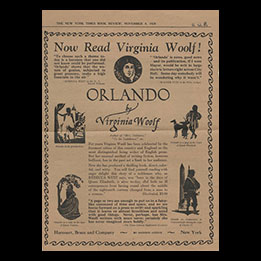
Harcourt, Brace & Company, Advertisement for Orlando by Virginia Woolf, November 4, 1928.
Edward Garland Fletcher Vertical File 205.G-2Based on her long-term relationship with author Vita Sackville-West, Virginia Woolf's Orlando follows the story of an English nobleman who transforms into a woman. Woolf, herself bisexual, challenged gender and sexual conventions in her published texts in the 1920s, such as her 1925 novel Mrs. Dalloway, which featured a same-sex kiss between two women. The New York Times 1928 book review of the novel praises the experimental nature of the text's attitude towards gender, time, and bodies. Illustrations show Orlando in a range of times from the Court of Elizabeth I to a modern woman living in 1920s England and married to a similarly gender non-conforming sea captain.
Critically well-regarded and re-assessed since her 1941 death, Virginia Woolf is today recognized as one of the most gifted and innovative English writers of the 20th century. Orlando, highly influenced by Woolf's own aesthetic as a modernist writer, sidestepped the challenges that The Well of Loneliness faced, and both Virginia Woolf and her husband, the publisher Leonard Woolf, spoke out against the censorship controversy that Hall experienced and the subsequent obscenity trials in the United Kingdom and the United States.

Langston Hughes, Scottsboro Limited (New York City: The Golden Stair Press, 1932).
Nancy Cunard Library UncatWhile American poet and author Langston Hughes offered no concrete evidence regarding his sexuality, biographers and those who personally knew him have intensely debated his private life since his death in 1967. Several of his unpublished poems seemingly allude to sexual relationships specifically with Black men, and a short story, Blessed Assurance, challenges constructions of masculinity and "manliness" through an effeminate black male child. Others, however, have argued that the author was in fact asexual. Regardless, Hughes's own prominence as a Black writer in pre-Civil Rights Era America and his own financial hardships did not offer him the privileges of openly expressing his sexuality that wealthier White authors might have enjoyed.
In Scottsboro Limited, Hughes focuses on the false accusations of sexual assault made by two young white women against nine Black male teenagers in 1931 Jim Crow Alabama. The 1930s-40s case involved several re-trials due to flimsy evidence, all-White juries, and mob violence. The story of these young men is remembered today as an example of the consistent miscarriage of justice against Black Americans in the United States, particularly when it came to white women falsely accusing Black boys and men of sexual assault.
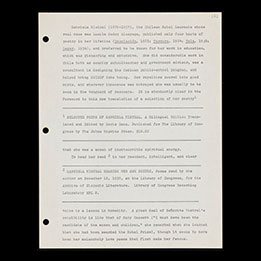
Guy Davenport, Review of Selected Poems of Gabriela Mistral, manuscript, undated.
Guy Davenport Papers 33.1The Chilean Nobel Prize-winning author, Gabriela Mistral, is widely recognized as one of South America's most important poets and has a nationally beloved reputation in her home country. Her life marred with tragedy, she wrote innovative, culturally significant poems for five decades until her death in 1957. Protective of her private life, she was posthumously discovered to have had relationships with women after the death of her long-time partner in 2006 and the subsequent publication of her private letters. Publicly remembered as a tragic, celibate Catholic figure, the existence and publication of the letters altered public memory of the poet, known as the "Mother of the Nation."
For queer writers and archivists, the 2007 publication of the author's private letters proves challenging. What obligations do archivists have to respect privacy, particularly after death? Furthermore, scholars debate whether or not Mistral would identify as a lesbian, bisexual, or queer at all in the present day, as political and social definitions of those identities have dramatically shifted since Mistral's death in 1957. Doubtlessly, both Mistral and Doris Dana, her partner who rejected claims that the two had formed a romantic relationship until the letters were unearthed after the latter's death in 2006, had their reasons for keeping their relationship private. How then do contemporary readers approach private material that had been tightly guarded by its owners while they lived? Does death overrule respect for privacy even if the richness of the letters between the two women and the ability to better understand the complex life of an incredibly gifted poet might otherwise remain secret?
Dress the Part: Clothing and Decoding Queerness
There's no simple summary of queer life in the early 20th century. Different nations, different cities, different social circles, and different amounts of privilege created a wide range of queer experiences. Within these spaces, queer people crafted thriving (if hidden) communities. Dress and clothing offered queer people the chance to identify each other through subtle hints and clues. In private, drag spaces offered places for people to push the boundaries of gender expression and performance through costumes and performances. In public, queer people made fashion statements that would follow their legacies to the present day. Several prominent queer women took advantage of less restrictive attitudes towards women in men's clothes. Author Willa Cather, for example, dressed in men's clothes while a student at the University of Nebraska and referred to herself as "William." Margaret Chung, a lesbian and the first Chinese woman to earn a medical degree in the United States, also donned trousers and neckties while a medical student and went by the name "Michael." While many of these people today might identify as transgender or nonbinary, it is difficult to offer such categorizations based on simple photographs. Furthermore, it is difficult to fully contextualize drag photographs. Are those pictured celebrating their own sexuality or gender identity or are they using drag to reinforce sexist stereotypes? For example, are cisgender, heterosexual people exaggerating gender stereotypes celebrating femininity or simply using it for laughs and reinforcing misogynistic tropes, as authors and theorists such as Judith Butler and bell hooks have suggested?
For Hall and Troubridge, clothing was a significant part of their queer identities and legacies. In addition to Hall's own well-documented preference for skirts and suitjackets, she wrote extensively about queer women's fashion in both her creative and private writing. When Hall published The Well of Loneliness, queer people in Europe and the United States responded with deep ambivalence about how "exposed" they felt by the information Hall included in her book. For example, Mormon lesbians in Salt Lake City, whom the lesbian sociologist Mildred Barryman interviewed in her research shortly after The Well of Loneliness's American publication, felt that signifiers in their community that provided senses of safety and unity (such as hairstyles and fashion) now became openly known to potentially hostile parties.
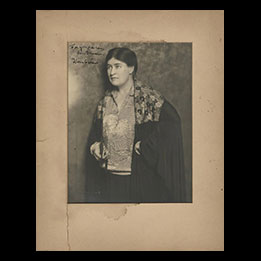
Nickolas Muray, photographer, Willa Cather, undated.
Alfred A. Knopf, Inc. Literary File Photography Collection 40.35American author Willa Cather experimented with clothing while attending the University of Nebraska, wearing men's suits and cutting her hair short. Known to refer to herself as "Willie" or "William" as a young person, her personal life and her relationships with women, both of which she guarded with fierce privacy, continue to spark debate and conversation in literary and historical scholarship. While some argue that her personal life offers unambiguous evidence that she was a lesbian, others argue that she would not have identified as such, regardless of her personal life.
While she did not explicitly take up queer themes in her texts, many literary scholars have interpreted the short stories Paul's Case and Tommy, the Unsentimental as queer.
She lived with her long-term partner Edith Lewis for four decades, had intimate relationships with several other women, including Louise Pound, the first woman president of the Modern Language Association. Recognized as one of the 20th century's best American writers, she won the 1923 Pulitzer Prize for Literature.
Cather's Alma Mater, the University of Nebraska, is in the process of digitizing her private letters and papers as part of the Cather Project and the Willa Cather Archive.
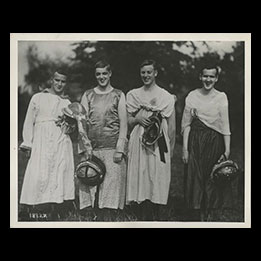
New York Journal-American, photographers, World War I soldiers dressed in drag, undated.
New York Journal-American Photographic Morgue 4053.2Archives across the world have ample photographs of people dressing in "drag." However, without full context, it is difficult to categorize these images as "queer" or not. For many LGBTQIA+ people, dressing in stereotypically "male" or "female" clothes offered a form of self-expression, comfort, and an opportunity to display gender in a way that made them comfortable.
However, non-LGBTQIA+ people frequently used and continue to use drag as a joke to reinforce sexist stereotypes. Men performing shows in dresses might include comedy based on misogynistic tropes, such as emphasizing ideas that women were overly-emotional, materialistic, or not to be taken seriously through comedy and jokes. Men in dresses in these contexts were typically meant to be funny and did not challenge cultural expectations of gender. Similarly, early 19th century minstrel shows, featuring white performers in blackface, frequently used drag and racist tropes to demean, humiliate, and emasculate Black men and portray Black women as either sexually promiscuous or domineering. Furthermore, Black men who wished to have any career on the stage were essentially compelled to participate in these sorts of shows if they wished for a career in professional acting. These kinds of performances were tolerated and not seen as obscene, as women were not allowed in minstrel shows until the 1890s, and the army would not have had women performers in World War One. Context matters, though it is frequently difficult to identify, especially considering that dressing in clothes not assigned to one's gender was illegal in many places until the late 20th century.
Further exploration into the Harry Ransom Center's vast collection of minstrelsy might be of interest to those wishing to further examine sexuality, gender, and race in American performance history.
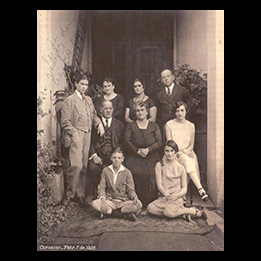
Guillermo Kahlo, photographer, Frida Kahlo and family, February 7, 1926.
Book Collection ND 1329 K33 A4 2007A young Frida Kahlo is photographed with her family, standing to the far left in a suit and with her hair slicked back. Openly bisexual, the Communist painter frequently used her trademark fashions as not only a form of self-expression, but as a recurring theme in her self-portraits. Disabled from polio and a bus accident in her youth, she was known as an adult for wearing colorful, pre-columbian skirts that covered her injured legs, but would also wear men's suits, especially in her self-portraits, and cut her hair short after her first divorce from her husband, the muralist Diego Rivera.

Unidentified photographer, Radclyffe Hall reading newspaper, undated.
Radclyffe Hall Literary File Photography Collection P-9Hall is seen here reading a newspaper in one of her trademark tailored suits. While short hair and wearing a combination of tailored men's jackets and shirts with a skirt was a somewhat popular fashion statement for those female-assigned people in post-World War I Europe and North America, queer women frequently used subtle choices in fashion to signify lesbian or bisexual identity to other lesbian and bisexual women. Hall included details about queer women's dress in The Well of Loneliness, causing a polarized reaction to the text from queer women who felt their identities, long "hidden in plain sight" and only noticeable to others within their community, were now publicly available and would expose them to harassment.
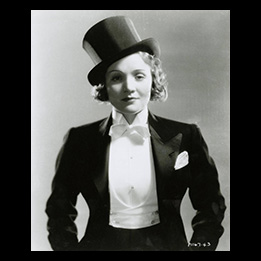
Unidentified photographer, Marlene Dietrich in film Morocco, 1930.
Book Collection P1167-43Bisexual actress Marlene Dietrich stars as cabaret singer Amy Jolly in the 1930 film, Morocco. The film, featuring a same-sex kiss between Dietrich and another actress, was made prior to the Hays Code. This production code dictated what could and could not appear in American movies from 1934 to 1968. Under these rules, queer characters could only appear in films as villains and had to be punished in some way by the end of the film.
Dietrich, however, drew inspiration for this role from her time in Berlin's cabaret nightclubs of the 1920s, which gave birth to a thriving community of queer artists and performers known collectively as the "Weimar period" in Berlin. Dressing in drag was not uncommon and art and performance regularly challenged popular notions about gender and sexuality.
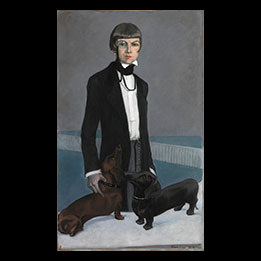
Romaine Brooks, artist, Una, Lady Troubridge, 1924.
Smithsonian American Art Museum 1966.49.6Painted by American lesbian artist Romaine Brooks, this likeness of Una, Lady Troubridge features her in the tailored suits of the day that provided some recognition of queerness. While Hall wore tailored suits, Troubridge typically appeared in feminine attire. However, for this painting, Troubridge adopts a modern wardrobe that contains multiple levels of subtext. Similarly, Romaine Brooks frequently wore clothing usually worn by men, capturing herself and several other women subjects in tailored suits painted in her signature gloomy palate of black, white, and grey. Subjects include not only Troubridge, but also Brooks's lover Ida Rubenstein.
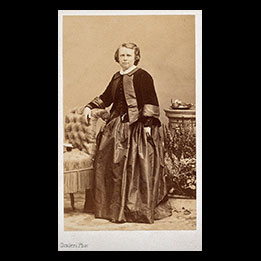
André-Adolphe-Eugène Disdéri, photographer, Rosa Bonheur, undated.
Wellcome Library 15246iRosa Bonheur was one of the most commercially successful women artists of all time and one of the few to achieve success in her life. Living relatively openly as a lesbian, she obtained special permission to wear trousers in 19th-century Paris so she could walk through the muddy fields where she painted horses. However, she also would wear ties, waistcoats, and dress-shirts even when not painting, citing the comfort and practicality of such clothing, particularly when compared to restrictive women's fashion of the time.
Best in Show: Dogs and the Aesthetics of Queer Modernism
These photographs represent the devotion between several queer modernists and their pets. By the modern period, dog breeding had become an increasingly popular fad for middle- and upper-class people. Born out of the rising gaps in wealth and the rise of a post-industrial revolution "middle class" in the Victorian Era, dog breeding offered queer authors and historical figures something of a "living brand." Several queer authors became synonymous with certain breeds (such as Hall's and Troubridge's dachshunds). To be sure, this movement was not apolitical. American and European governments were actively using pets and "animal compassion" to justify foreign colonization. Obsessed with scientific "genetic engineering," dog breeders and "pure-bred" enthusiasts likewise tended to dabble in the eugenics movement. Gertrude Stein, Alice B. Toklas, Radclyffe Hall, and Una Troubridge all offered at least some soft support for eugenics in their respective writings, casting a political shadow of where middle-class fascination with "pure-bred" dogs ended and "pure-bred" humans began.
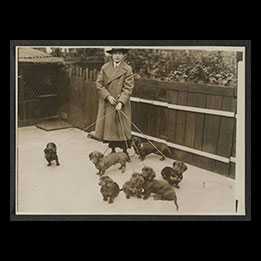
Unidentified photographer, Radclyffe Hall with dachshunds, undated.
Radclyffe Hall and Una Vincenzo, Lady Troubridge Papers 25.5Late Victorian England saw an overlap between rising popularity in Darwin's theories of evolution and the early eugenics movement. Eugenics, the idea that a species can be "purified" by only letting "fit" members of it breed, led to widespread harm as it began to be applied to humans. However, upper-class Victorians relished in the thought of having "pure-bred" dogs, going so far as to start "kennel clubs" to certify a dog's pedigree.
While Hall expressed at least some support for eugenics, her obsession with "pure-bred" dogs was not unique to her. Countless people with the funds to do so invested heavily in dog breeding, causing significant health problems for puppies who stood higher chances of genetic mutations due to a large reliance on inbreeding.
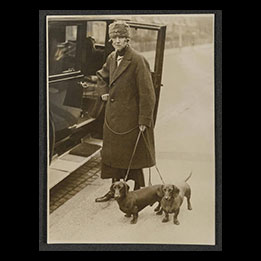
Unidentified photographer, Una Troubridge with dachshunds, undated.
Radclyffe Hall and Una Vincenzo, Lady Troubridge Papers 25.5Here we see Lady Troubridge walking two of the pair's dachshunds. Not unlike clothing, dogs offered fashion-conscious, urban, upper-class people a chance to make dog breeds part of their "aesthetic."
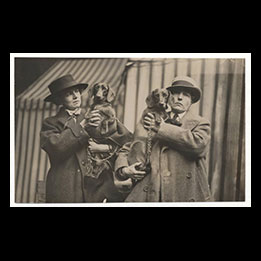
Sport & General Press Agency, Ltd., Radclyffe Hall and Una Troubridge with their dachshunds at Crufts Dog Show, February 1923.
Radclyffe Hall and Una Vincenzo, Lady Troubridge Papers 25.5Here we see Hall and Troubridge, both wearing more conventionally masculine ties and hats, holding their beloved dachshunds.
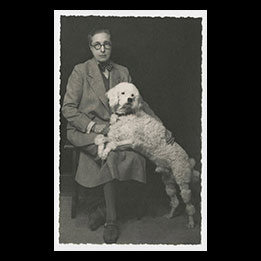
Giuseppe Magrini, photographer, Radclyffe Hall with poodle, undated.
Radclyffe Hall Literary File, Photography Collection P-12A member of the Zoological Society and an animal lover, Hall is depicted here with a white poodle. Victorian and Edwardian England saw a significant shift in attitudes towards animals. As the violence and terror of European and American Colonization became increasingly clear, many White Europeans and Americans who benefited from settler colonization, sweatshop labor, and other human rights abuses emphasized their benevolent attitudes towards pets and animals to "soften" their images and distract from the racism and cruelty they weaponized against other people.
Americans, for example, emphasized their bans on cockfighting and bullfighting in territories seized from the Spanish after the Spanish-American War. British readers turned Anna Sewall's Black Beauty into a global best seller, causing a strong public reaction in favor of preventing animal cruelty, while British colonization ravaged human populations and ecosystems across the world.
For Hall, her adoration of dogs and other animals did not always extend to her views on humans. She held controversial right-wing opinions and offered some degree of support to both fascism and anti-Semitism at different times in her life.
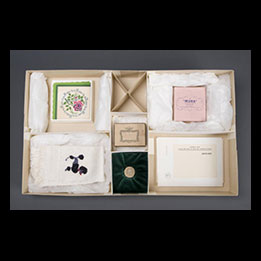
Cannon, manufacturer, Hand towel with embroidered poodle owned by Gertrude Stein and Alice Toklas, undated.
Carlton Lake Collection of Gertrude Stein 2.73Gertrude Stein and Alice Toklas, known for their Paris home that became a beehive of modernist artists and writers, were also the doting owners of several dogs, most famously their standard white poodle.
Their toiletry set, featuring a hand towel with a black poodle on it, demonstrates not only their love for their pet, but also the poodle's unique overlap between pet and fashion accessory.
Like Hall and Troubridge, however, Stein and Toklas held racist and ableist beliefs that manifested in their personal politics and their creative writing. Concerned about interracial marriages and immigrants moving to the US, Stein hints towards sympathies for eugenics and vocally supported the fascist government in Vichy France, going so far as to offer her services as a "propagandist" for Philippe Pétain, a Nazi collaborator and leader of Vichy France. While modern Stein scholars debate her reasons as a queer, Jewish woman for offering to collaborate with the Nazi puppet state, it none-the-less clouds her legacy for contemporary readers.
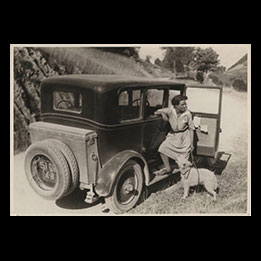
Unidentified photographer, Sylvia Beach with dog, undated.
Carlton Lake Collection of French Manuscripts 264.1Sylvia Beach is pictured here with a dog. Both she and her partner, Adrienne Monnier, were noted dog lovers and frequently traveled with their pets on their vacations.
Her interaction with animals was not limited to pets. After refusing to sell books to the Nazis occupying Paris and threatened with arrest and forced closure of her store, Beach hid her book collection and painted over the name of Shakespeare and Co. Later, she spent several weeks imprisoned with other American women in cages at the Bois de Boulogne zoo in Paris.
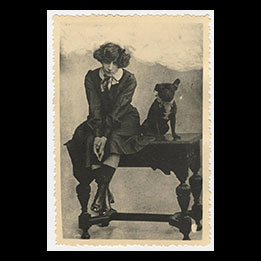
Gerschel, photographer, Colette with dog, undated.
Carlton Lake Literary File Photography Collection 4.5Here we see the French writer Colette photographed with a dog. The dog here serves a dual purpose. It is both an affectionate companion and a fashion accessory, matching the author's dark dress as she sits posing on a table.
Weird Science: Modernism, Queerness, and Early Psychology
Rapid advances in science, chemistry, and the birth of psychiatry in the late 19th and early 20th centuries led to wide-spread cultural shifts when it came to ideas of race, gender, biology, anthropology, and human sexuality. However, for many marginalized people, the impact was harsh. Concepts like "scientific" racism, sexism, eugenics, social darwinism, and the categorization of queer identities as "medical disorders" dressed up prejudice with the "authority" of science and medicine. While these concepts and prejudices were not new, the use of "science" to make them seem factual rather than based on bias and white supremacy, caused new ways for medical and scientific communities to further harm marginalized people. While philosophers and early geneticists had theorized about the "biological qualities" that they felt made white people superior, Victorian science felt it could provide "hard" facts to support these theories. Queer people of color particularly bore the brunt of these "advances." The dead bodies of people of color (such as Sarah Baartman) were displayed in museums, with academics seeking to produce "hard evidence" to connect race to certain physical and sexual traits. Modernists were not immune from such racism and ableism either. Gertrude Stein expressed anxiety about immigrants in America and fears around interracial relationships. Similarly, Havelock Ellis, who co-authored the first English-language book on same-gender attraction and what would today be called transgender psychology, was also an enthusiastic eugenicist. Early psychologists, influenced by Freud, sought to categorize same-sex attraction as a psychological disorder that could be medically treated. However, while Hall and Troubridge might have pushed back on prejudice against queer people, they readily participated in other popular sciences of the time that contained significant prejudice and biases. Some of these were relatively harmless, such as their mutual interest in spiritualism and using advances in science to contact the dead. They, along with Arthur Conan Doyle, were members of the Society for Psychical Research. However, both were also eugenics enthusiasts and offered support to right-wing social Darwinist political movements.
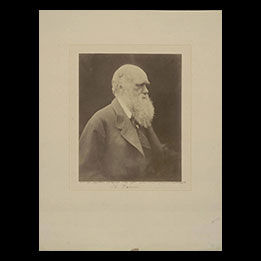
Julia Margaret Cameron, photographer, Charles Darwin, 1868.
Julia Margaret Cameron Photography Collection 964:0037:0082Darwin's 1859 book, On the Origin of Species, sent shockwaves through Europe's scientific community. It sparked new interest in zoology and gave rise to anthropology, two subjects that deeply fascinated Radclyffe Hall and Una Troubridge. However, it also re-ignited conversations about "scientific racism." The Victorian Era saw a boom of advances in science and medicine. However, those fields, dominated by white men of the upper class, frequently sought to give scientific authority to concepts like sexism, racism, and ableism.
Using Darwin's theories on "survival of the fittest," scientists, psychologists, zoologists, and anthropologists frequently used "scientific" racism to argue that there were innately "fit" and "unfit" people.
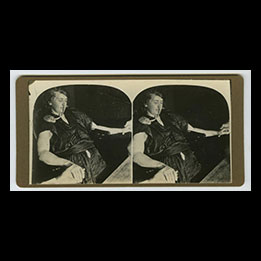
Unidentified photographer, Medium Mina Crandon, also known as Margery, during séance, undated.
Arthur Conan Doyle Literary File Photography Collection 2.12Both Hall and Troubridge were members of the Society for Psychical Research, along with author and spiritualism enthusiast Arthur Conan Doyle.
While the Society was interested in any "psychic" or paranormal concepts, it became most closely associated with its role in debunking spiritualists. Born out of mid-19th-century fascination with communicating with the dead, spiritualism and its practitioners adopted scientific innovation to speak to those "beyond the grave." Doyle attended numerous seances, recording them, interviewing mediums, and attempting to find a scientific method of contacting the dead, or at least giving the now-debunked field some air of scientific authority. He left the society due to what he felt was a sense of hostility and skepticism towards spiritualism.
This photograph, taken of a medium during a seance, marks the manner in which technology and spiritualism developed. Both deep believers in Spiritualism, Hall and Troubridge used seances to attempt to contact Hall's deceased partner, Mabel Batten. Hall's involvement in the society was also the source of scandal. Seeking a leadership position, she faced harsh criticism from a friend of Troubridge's ex-husband, who threatened to publicly accuse her of "immoral behavior."
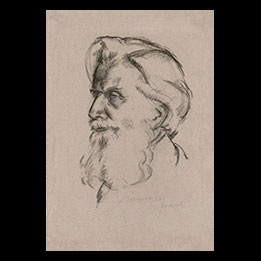
Desmond Harmsworth, artist, Drawing of Havelock Ellis, 1932.
Desmond Harmsworth Art Collection 1.2Interests in psychology in the late 19th century created complicated situations for queer people. While queer relationships have existed as long as human relationships have, it was not until the Victorian era that many terms used today became popular. "Homosexuality" as a term came from psychology, in which it was classified as a disorder, and has since fallen out of popular usage. Hall and Troubridge used the term "inverts." Sexologists, those who studied human sexuality through psychology and behavior, popularized the term, specifically Richard von Krafft-Ebing and Havelock Ellis (drawn here), who wrote the foreword to The Well of Loneliness. The protagonist of the text, Stephen Gordon, is described as a "sexual invert," a term broadly used to define people whose sexuality and gender-related behavior transgressed social boundaries for the time.
Within The Well of Loneliness, Stephen reads about "inversion" from a book by Krafft-Ebing, helping her define her lesbian identity in scientific terms of the day.
The term, however, was not innocent. While Ellis did not regard "inversion" as a deficit and simply regarded it as "different," psychological debates over human sexuality and LGBT identity had lasting consequences. The American Psychological Association did not change this categorization until 1975. Psychiatrists practiced a range of medical experiments searching for a "cure," and conversion "therapy" and other quack science is still used today, drawing on now debunked early psychiatric opinions about same-sex attraction and transgender identities.
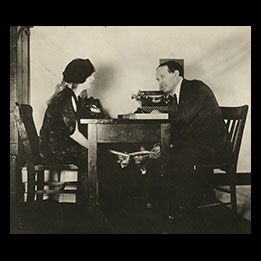
Unidentified photographer, Spirit Exposé, circa 1920s.
Harry Houdini Papers 14.6While spiritualism was undoubtedly in decline by the mid-point of the 20th century, passionate spiritualists still remained. Harry Houdini, a believer in spiritualism but notorious for attempting to expose quack mediums, frequently butted heads with other prominent spiritualists who he felt were too gullible in their willingness to accept dubious evidence as proof of contact between the living and the dead.
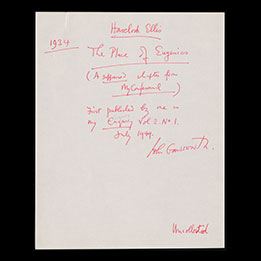
Havelock Ellis, "The Place of Eugenics," manuscript, 1934.
Havelock Ellis Collection 1.1In addition to his work as a sexologist, Havelock Ellis was an outspoken supporter of the eugenics movement. This movement, born out of "social Darwinism" and the belief that genetics and selective breeding could perfect the human race, was a widely popular field of interest during Hall's and Troubridge's lifetime. While the movement lost popularity in Europe and North America following Nazi attrocities in World War II, eugenics had a popular following in the United States and England. This led to forced sterilizations, state laws that banned "ugly" people from appearing in public, and advocacy for euthanasia in some circles. People of color, particularly those who were disabled and low-income, were frequent targets for eugenics advocates, whose political sympathies ranged from left to right. Famous eugenicists included Helen Keller, Theodore Roosevelt, and George Bernard Shaw.
While eugenics was an unambiguously harmful and violent movement that led to forced sterilizations in the US and Europe, many eugenicists did not necessarily believe in the widespread genocide and murder that the Nazis later committed.
However, while popular, this movement had notable opponents who argued that the practice was racist, damaging, and a poor substitute for poverty elimination and social reforms.
The House that Harlem Built: Queer Life and Renaissance in Communities of Color in the Early 20th Century
Laws in the early 20th century closely scrutinized queer people. Victorian sexual morality laws spread throughout the world due to settler colonization, challenging traditional beliefs about sexuality and gender on a global level. For White and wealthy queer people, LGBTQIA+ identities frequently were still defined in relation to Christian understandings of sexual and emotional monogamy. For people of color, sexual and romantic practices connected to indigenous beliefs were at particular risk. Furthermore, a lack of social privilege made law enforcement much likelier to enforce Western laws against them. The Zuni diplomat We'wha, a well-known ihamana (a male-assigned person who lived as a woman within Zuni culture), was eventually arrested for practicing "witchcraft," despite having previously met with President Grover Cleveland, and despite their close associations with prominent anthropologists of the time. For Black Americans, segregation, Jim Crow laws, and lingering economic and political legacies of slavery made community building important and crucial for Black communities, which maintained performance tradition, art, and culture. The Harlem Renaissance era (which saw Black arts and culture movements in a range of American cities) offered prominent black writers and performers the chance to craft diverse gender expressions and sexualities with relative degrees of "openness." William Dorsey Swann crafted a notable underground culture of drag balls and clubs in late 19th-century Washington, DC with a clientele that largely consisted of formerly enslaved people. Blues singers like Gladys Bentley (who dressed in men's clothing) and Ma Rainey sang unambiguously about having romantic and sexual relationships with other women. Gladys Bentley, having been familiar with Hall's work, recorded a song entitled "In My Well of Loneliness" in 1937. However, racism, associations between LGBTQIA+ identities and Communism in the US, and Prohibition that closed many Black nightclubs and performance venues have obscured significant portions of these rich histories.
While there was undoubtedly social overlap between queer people of color and White queer people, White queer people still willfully benefited from White privilege and actively participated in racist institutions and politics. In addition to her own right-wing politics that were rooted in racist beliefs, Hall wrote several pieces (including The Well of Loneliness and the short story The Career of Mark Anthony Brakes) that relied heavily on racism against Black and Indigenous people. While such a belief system was not uncommon among elite white women at the time, Hall left evidence in her writing that she found Black music and culture interesting, though her interest did not manifest in ways that might have lended support for racial equity and civil rights justice.
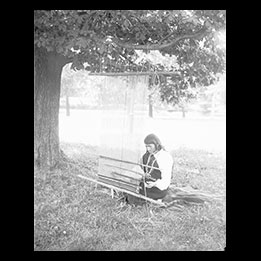
Unidentified photographer, We-wha weaving, undated.
Smithsonian Institution BAE GN SI 3644Ihamana, such as the diplomat and artist We'wha, became something of a fixation for White anthropologists in the late 19th century. A gifted weaver and potter, We'wha joined communities of other Zuni Ihamana people who engaged in crafts, arts, and Zuni cultural preservation. Globally, sexualities and genders beyond European binaries and expectations of heterosexual monogamy existed and thrived in numerous cultures throughout history. With the growing influence of colonization, however, these identities became regulated and punished by White, Christian missionaries and legal governments. Vast troves of queer history were deliberately destroyed and lost through colonization and genocide against indigenous people. Similarly, museums frequently acquired artifacts from wiped-out indigenous communities without much regard for culturally responsive display or treatment of those artifacts or the people who created them. While we do have historical records of a few notable people who practiced traditional beliefs that did not comply with gender binaries and Christian sexual ethics, it is impossible for modern audiences to know how many of these stories were deliberately or inadvertently erased from history.
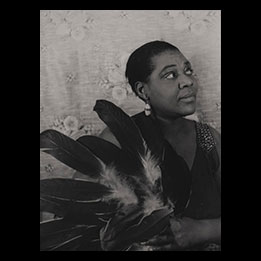
Carl Van Vechten, photographer, Bessie Smith, February 3, 1936.
Theater Biography Collection PA-00089Singer Bessie Smith was one of the most highly regarded and highly paid blues and jazz performers of her time. Openly bisexual, she had numerous romantic partners over the course of her life.
She grew up in poverty in Chattanooga, Tennessee, performing on street corners and in vaudeville and minstrel shows. Fellow queer blues pioneer Ma Rainey mentored Smith in her early years, and by the time of her premature death in a car accident in 1937, she became globally known for her gifts as a musician.
Despite her popularity, she was buried in an unmarked grave until 1970 when former employee Juanita Green and bisexual singer Janis Joplin (who cited Smith as a major influence) purchased a grave stone for her.
Similarly, pioneering blues singer Big Mama Thornton (whose recording of "Hound Dog" is excerpted here) transgressed expectations for Black American women, frequently dressing in men's clothing and performing in an industry dominated by men. While many biographers speculate that she was a lesbian, her personal style of wearing fedoras, slacks, and men's button downs certainly challenged the more feminine aesthetics that dominated dress and behavior for Black women in mid-century America.
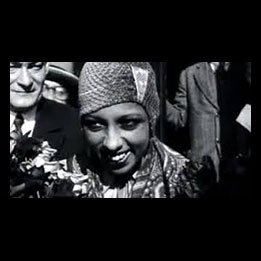
Polygoon-Profilti, producer, Newsreel of Josephine Baker arriving in The Hague, August 1, 1928.
Netherlands Institute for Sound and VisionAn icon of 1920s Paris, a Civil Rights advocate, and a French Resistance member, Josephine Baker's fascinating life as a queer woman of color made her a lasting emblem of Black art and culture in the jazz age and a tireless soldier in the fight for equal rights.
Known for her innovative and provocative dancing that made her a superstar in pre-World War II Europe, Baker commented publicly on the challenges she faced as a Black entertainer in the United States and refused to perform in segregated venues, despite highly lucrative offers to do so.
She was decorated by the French government for her efforts in the French Resistance during the Nazi occupation in the 1940s, using her celebrity to spy on high-ranking officials and pass along secret messages. After the war, she performed for a range of audiences, including sold-out performances for Castro in Cuba and Tito in Yugoslavia.
Committed to the American Civil Rights movement, she spoke at the March on Washington in 1963 while wearing her military medals, one of the few women to speak at the event despite the presence and planning of Black women civil rights leaders.
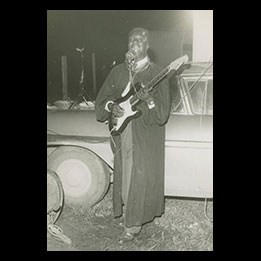
John E. Palmer, photographer, Preacher with electric guitar, undated.
John E. Palmer Papers and Photography Collection 8.4Photographed by Galveston photographer John E. Palmer, this preacher with an electric guitar marks the rise of Gospel and Rock-n-Roll as musical genres in which a range of Black artists rose to prominence in the 1940s and 1950s.
Widely influential to later rock-n-roll artists such as Elvis Pressley, Little Richard, and Johnny Cash, Sister Rosetta Tharpe scandalized and delighted audiences by appearing as a woman singing gospel while playing the electric guitar. Her innovative fusion of gospel music and her skills as a guitar player helped define rock-n-roll in its early years. Speculation around her sexuality persists, including a possible relationship with fellow gospel singer Marie Knight, with whom she toured.
Black excellence in music and art was not exclusive to urban areas. Popular across the country, Sister Rosetta's music appealed to a range of communities, including countless queer people of color, and her considerable talents as a guitarist and singer provided incalculable influence to later rock-n-roll artists.
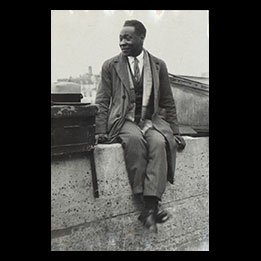
Unidentified photographer, Claude McKay, undated.
William A. Bradley Literary Agency Records 43.8Jamaican author Claude McKay, a Harlem Renaissance writer, wrote and collaborated with a range of writers experimenting with meter, rhythm, and subject matter during the 1920s. A frequent attendee to openly gay L. S. Alexander Gumby's studio, McKay met fellow queer, Black writers, such as the philosopher, university professor, and "Godfather of the Harlem Renaissance," Alain LeRoy Locke. Locke served as a literary and personal mentor to many Harlem writers, queer or not, and edited The New Negro (1925), an anthology of Black poetry, fiction, and essays.
Both McKay and Locke spent time in Weimar Germany in the 1920s, where McKay became fascinated with modernist art and architecture, such as works of the Dada movement. A great many Black artists and thinkers spent time in Europe, including educator Jessie Redmon Fauset, who also mentored McKay, to not only escape the enormous challenges of life in Jim Crow America, but also to further study and experiment with new artistic and intellectual movements.
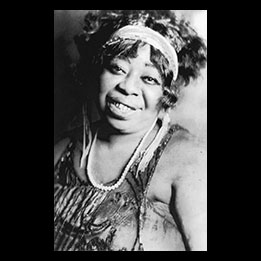
Unidentified photographer, Ma Rainey, circa 1923.
Wikimedia CommonsPioneering blues singer Ma Rainey recorded the "Prove it On Me Blues" in 1928, the same year that Hall published The Well of Loneliness. The song includes explicit references to lesbian attraction to women and dressing in men's clothes, both risky lyrics that could have resulted in legal consequences. Rainey herself was arrested in 1925 in Chicago for hosting a lesbian party. Police arrived at Rainey's residence responding to a noise complaint and found several naked women in "intimate" poses. She was bailed out the following morning by her friend Bessie Smith. An icon in R&B music and a mentor to other women blues singers, Ma Rainey's openly queer persona and lyrics during the 1920s and 1930s remains an important piece of queer cultural history. Her song, "Cake Walk," demonstrates her style as a performer, mixing humor and her skills as a musician to fit the early style of blues performance.
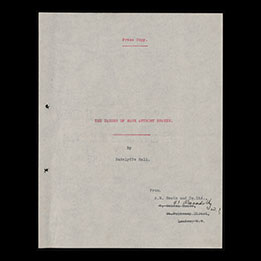
Radclyffe Hall, "The Career of Mark Anthony Brakes," manuscript, circa 1914-1915.
Radclyffe Hall and Una Vincenzo, Lady Troubridge Papers 18.5Racism still persisted in queer communities. White queer people did not hesitate to use White privilege when it suited them, and many were openly racist and hostile to people of color, Hall being no exception.
Hall was certainly aware of the contributions of Black artists in America, citing Harlem Renaissance performers in her writing.
Though she believed herself to be writing progressively about race and though she was familiar with the work of Black thinkers like Booker T. Washington, Hall had limited contact with people who were not White. Her text makes references to racial essentialism, classifying Black Americans as a "race born of slaves," and would widely be regarded as racist by modern readers. Though she felt she was writing about other "misfits," with whom she claimed to feel kinship, Hall held deeply racist and classist beliefs that, while typical of women of her race and class at the time, manifested themselves through harmful stereotypes in her writing and personal politics.
Takedown Notice: This material is made available for education and research purposes. The Harry Ransom Center does not own the rights for these items; it cannot grant or deny permission to use this material. Copyright law protects unpublished as well as published materials. Rights holders for these materials may be listed in the WATCH file. It is your responsibility to determine the rights status and secure whatever permission may be needed for the use of any item. Due to the nature of archival collections, rights information may be incomplete or out of date. We welcome updates or corrections. Upon request, we'll remove material from public view while we address a rights issue. The unpublished works, correspondence, diaries, and daybooks of Una Vincenzo, Lady Troubridge are under copyright in the United States. The Ransom Center is grateful to Alessandro Rossi Lemeni Makedon, the representative of Troubridge's estate, who has granted permission for the Center to share the papers of Troubridge.

